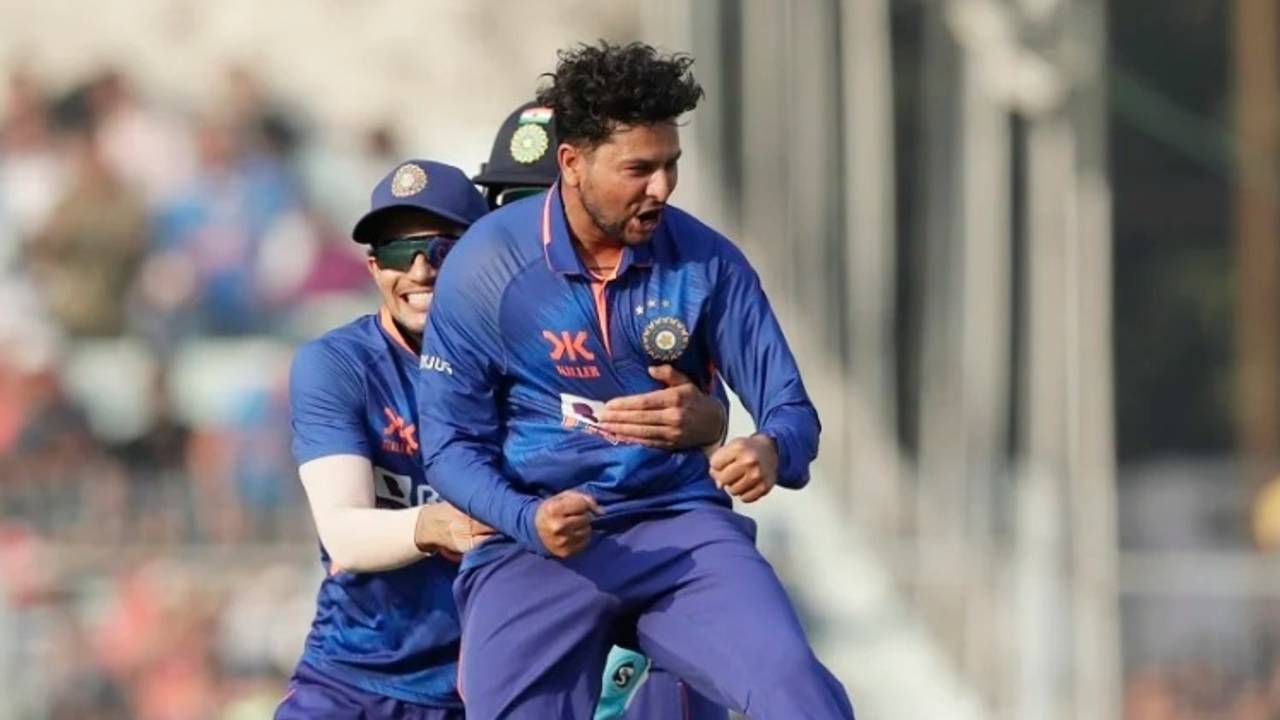Kuldeep emerges from the shadows again with another match-winning performance
India's XI has space for only one wristspinner and Kuldeep is giving Chahal tough competition for the spot
Sreshth Shah
13-Jan-2023
Let us compare Kuldeep Yadav's ODI numbers with Jasprit Bumrah's. Kuldeep has played 74 games, taken 122 wickets, has a strike rate of 32.30 and an average of 28. Bumrah has played 72 games, taken 121 wickets at a strike rate of 31.40 and an average of 24.30. Kuldeep got to 50 and 100 wickets in his 28th and 57th ODIs respectively; Bumrah got to those respective landmarks in his 24th and 58th ODIs. Bumrah has four Player-of-the-Match awards; Kuldeep won his fourth on Thursday, for taking 3 for 51 in second ODI against Sri Lanka.
However, the comparisons end there because Bumrah's combination of high pace, an awkward action and great accuracy is a rare skillset. While Kuldeep's left-arm wristspin is also uncommon, he will continue to be measured alongside legspinner Yuzvendra Chahal. And with India almost certainly going to play at least one fingerspin-allrounder - Axar Patel, Ravindra Jadeja or Washington Sundar - at the ODI World Cup, the equation is no longer Kuldeep and Chahal in the XI. It is Kuldeep or Chahal.
Six years ago, Virat Kohli had decided that having wicket-taking options in the middle overs was crucial to winning ODIs. Kuldeep and Chahal were at the right place at the right time and spun India to a lot of success. But as oppositions played the wristpinning duo more often, the more comfortable they got. Gradually, both bowlers lost their wicket-taking potency and Kuldeep, in particular, tended to have more bad days than Chahal. That seeped into Kuldeep's IPL performances too, like in 2020, when he struggled to keep his place in the Kolkata Knight Riders XI and took only one wicket in the five matches he got.
That was a crucial juncture in Kuldeep's career. From the outside, he looked all over the place and was out of contention for an India spot. But those closer to the action say Kuldeep wasn't discarded. India's team management worked to rehabilitate him physically, mentally and also focussed on his skills. He overcame his fear complex and with nothing left to lose, Kuldeep reinvented himself with a vigour in his action that helps him get more drift and dip.
On Thursday, a lot of that was on display as Kuldeep came to bowl in the 17th over of the second ODI against Sri Lanka at Eden Gardens. India needed a wicket desperately with Nuwanidu Fernando and Kusal Mendis on track for a century stand for the second wicket. Kuldeep got a googly to turn across Mendis and hit his pads, breaking the partnership with a googly. Dasun Shanaka, who has tormented India with the bat, was Kuldeep's second scalp - bowled around his legs while sweeping. In that same spell, Kuldeep used the googly again to dismiss Charith Asalanka, who pushed with hard hands at a ball not full enough only to give Kuldeep a return catch.
Kuldeep's three wickets, along with Axar Patel's dismissal of Dhananjaya de Silva and a run-out, caused Sri Lanka to slump from 102 for 1 to 126 for 6. They never recovered, and Kuldeep's triple-strike ensured India only needed 216 to win.
I also want to say thank you to Chahal. I walked into the team from a Test series, but you [Chahal] played the T20s and the last ODI. Your inputs on how to bowl helped, so thank you. Small inputs always help. It is unlucky we are not playing so much together these days on the field but your tips have helped me a lot.Kuldeep Yadav
"My focus was to bowl good length," Kuldeep told bcci.tv after the game. "I have played at Eden a lot and the pitch isn't great for spinners. Bowling good length meant I can avoid giving room. And from there use my variations - to turn it away or bowl the googly. I have also been bowling with an aggressive rhythm, and the variation in pace left the batters unsure on whether to play off the front foot or the back foot.
"My mindset now has changed a lot. Earlier I thought I need to give good performance and take wickets. Now it is that I should bowl to my strengths and not bowl bad bowls. And as you know, wickets will definitely come if you're a wristspinner bowling in good areas."
Kuldeep wasn't India's first-choice spinner for the match. He played only because Chahal picked up a shoulder niggle in the first ODI and had not recovered in time. When Chahal does regain full fitness, India will have to decide whether to bring him back, or give Kuldeep more games. While this healthy rivalry for one spot continues between India's two premier wristspinners, their camaraderie remains like old times.
"I also want to say thank you to Chahal," Kuldeep said after the game. "I walked into the team from a Test series, but you [Chahal] played the T20s and the last ODI. Your inputs on how to bowl helped, so thank you. Small inputs always help. It is unlucky we are not playing so much together these days on the field but your tips have helped me a lot."
There's no guarantee that Kuldeep will make the cut for the final ODI against Sri Lanka. He took 4 for 18 in an ODI against South Africa in October last year, and then was left out of subsequent XIs until the tour of Bangladesh in December. And despite taking eight wickets in the first Test at Chattogram - a Player-of-the-Match performance - he was dropped for the second in Mirpur. So if he does play at Thiruvananthapuram, enjoy Kuldeep 2.0 because there are few things in cricket as beautiful as a left-arm wristspinner in full flight.
Sreshth Shah is a sub-editor at ESPNcricinfo. @sreshthx

